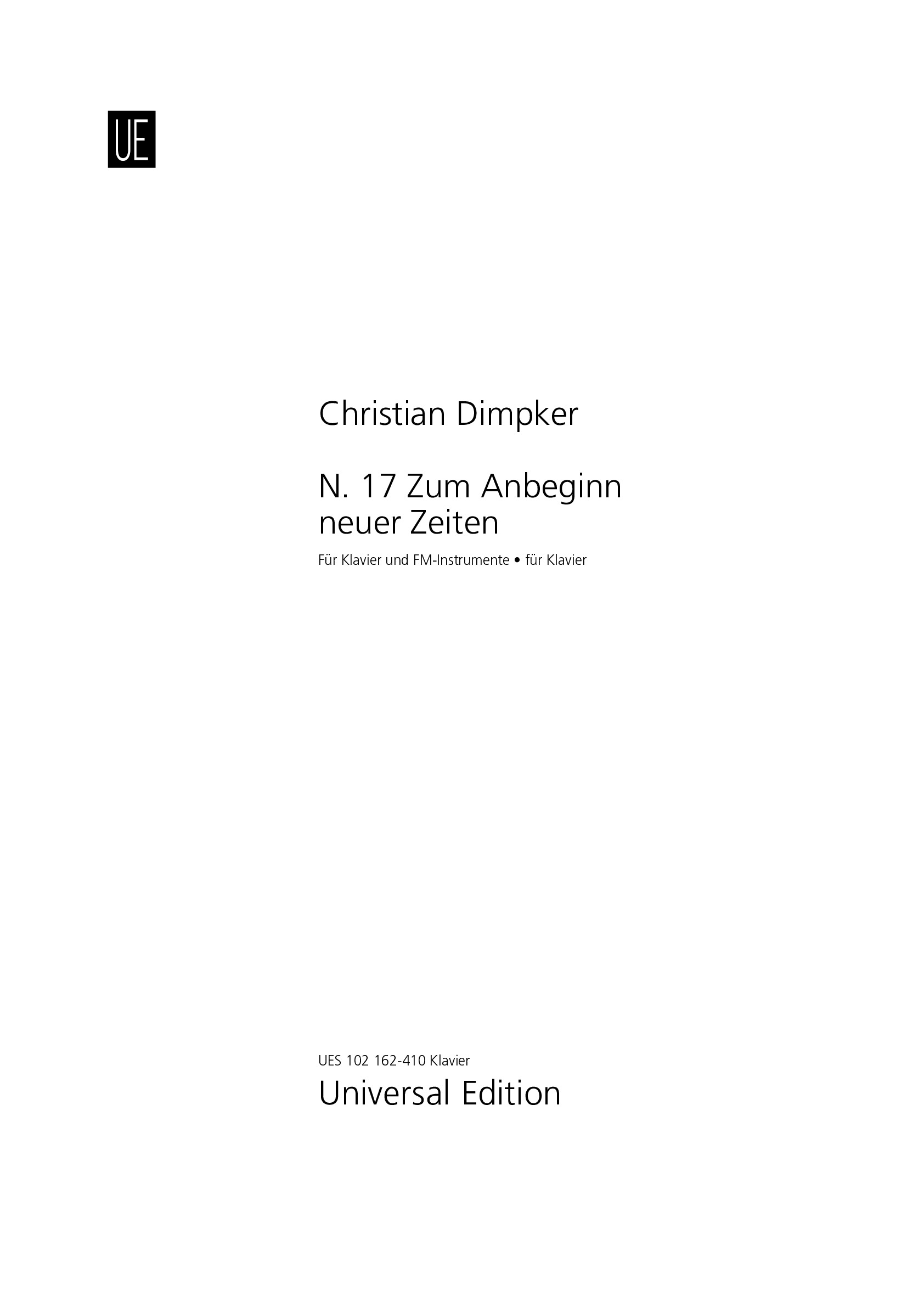

Christian Dimpker
N. 17 Zum Anbeginn neuer Zeiten
Duration: 15'
Solos:
piano
N. 17 Zum Anbeginn neuer Zeiten
Translation, reprints and more

Christian Dimpker
N. 17 Zum Anbeginn neuer ZeitenOrchestration: Für Klavier und FM-Instrumente
Type: Noten
Sample pages
Video
Work introduction
The basic idea of Zum Anbeginn neuer Zeiten is that actually two pianos are playing – one grand piano and one synthetic piano. The synthetic piano is based on the sound synthesis process referred to as frequency modulation (FM). In a paper written by Bill Schottstaedt, one can see how this technique may be used to simulate the timbre of pianos. This approach was transferred to notated electroacoustics. The further the four piano pieces progress, the more this simulation is transformed, while the unleashed hand of interpretation may support this effect enormously in this piece. In addition, the notation of the FM instruments becomes more and more complex, while the original timbre is increasingly distorted. The work stands for the start of something new, it originated from a phase of new beginnings. The work itself is novel in its dissolution of the boundaries of playing techniques and in terms of the detailed notation of electronics. It forms the beginning of the end, stands on the verge of turning away from instrumental composition and before the extension of notation to extra-musical areas such as light art.
What is necessary to perform this work?
Aside from the piano, instruments based on frequency modulation (FM) are utilised. These FM instruments simulate the (basic) sound of a piano. They are inspired by Schottstaedt’s paper entitled »The simulation of natural instrument tones using frequency modulation with a complex modulating wave« (In: Curtis Roads und John Strawn (Eds.): Foundations of Computer Music. Cambridge 1987, pp. 54-64). The process described by Schottstaedt is employed in Klavierstück I and further modified in the other pieces. All FM instruments are complemented by a convolution reverb (industrial complex, 4.4 sec.) and further electroacoustically transformed at the interpreters’ discretion. These transformations of the two FM instruments are then also applied to the grand piano via four contact microphones that send to all four loudspeakers. Their positions inside the piano are free, but they should be positioned in a similar way as the loudspeakers they send to (this change was employed after the premiere of the work). An electronic version of the piece can also be created by combining only the signal from the contact microphones (and not the original sound of the piano) with the FM instruments.
The pianist is supposed to perform actions inside the piano in Klavierstück I-III. Therefore, the strings A0-C#2 of the utilised piano model need to be accessible. Additionally, the strings D3-F#3 need to be played closed to the dampers as well as the strings Eb5-D6 and A6-C8 need to be completely accessible. Hence the piece may be played on the current piano models (cf. Christian Dimpker: Extended notation. The depiction of the unconventional. Vienna et al. 2013, pp. 330-334). Cross beams need to be detached when necessary. The piano is, in some cases, picked up by two microphones (polar pattern: cardioid, the type may be chosen freely) and sent to four loudspeakers. The FM instruments also send to these four speakers. Their frequency response should be linear. The loudspeakers are complemented by a subwoofer (ad libitum). Their disposal is depicted on page V. The Klavierstücke I-IV are connected. They need to be performed as a single piece. All other information can be found in the score.
Download the FM files (no effects): https://e.pcloud.link/publink/show?code=kZtlllZ4dxpNWu3eaR9YMJ1S1xQYbTlAN2k
